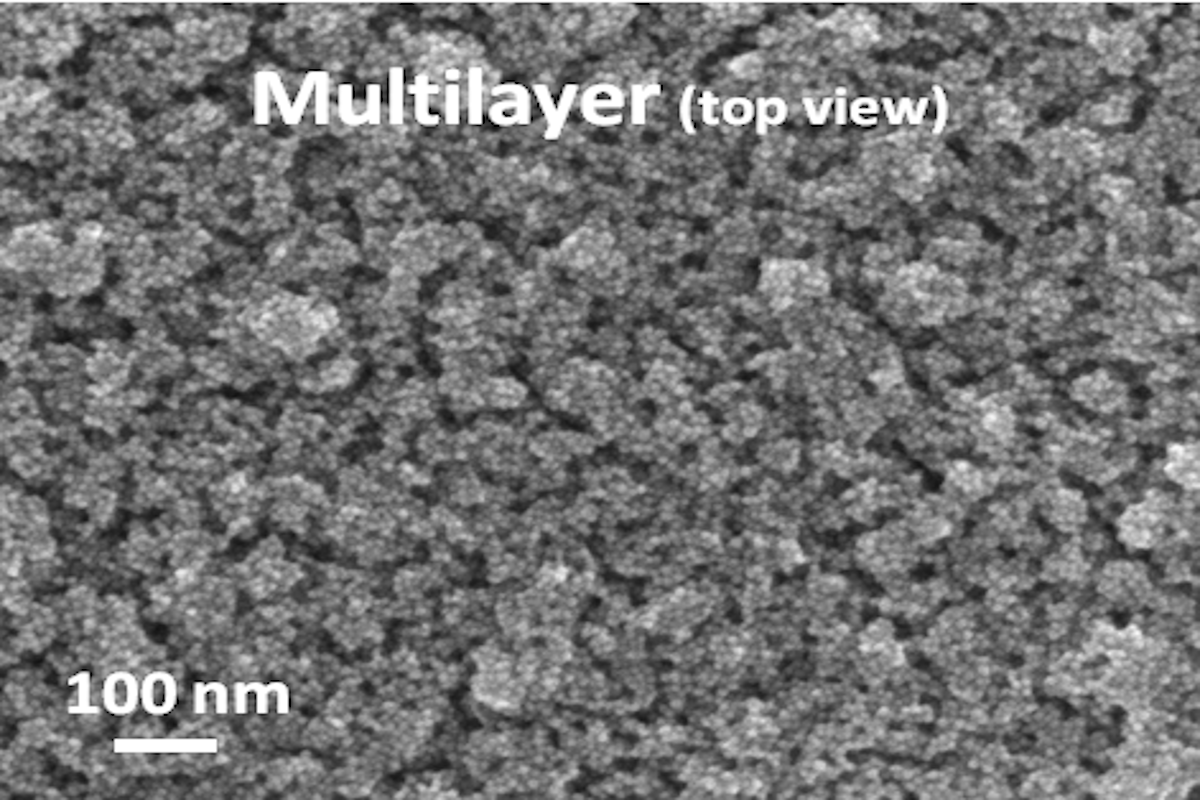Owing to their original collective properties, magnetic nanoparticles are of great interest for the development of new spintronic devices. In this context, we aim at controlling the assembling of magnetic nanoparticles on substrates to study their collective properties. We focus mainly on magnetite (Fe3O4) which combines efficient magnetic properties (high magnetic anisotropy, and magnetization) to conductive properties and is suitable for magnetic and magneto-resistive devices.
Assembling techniques
Assembly Sumarry
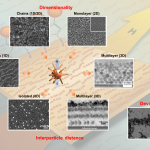
Regarding the assembling of nanoparticles, we are particularly involved in the Langmuir-Blodgett (LB) technique and surface patterning by self -assembled monolayers (SAMs) of organic molecules. The Layer-by-layer technique and mesogen phases in collaboration with other groups complete this panel.

Approaches performed to control the assembling of nanoparticles
The Langmuir-Blodgett technique process through the formation of nanoparticle monolayer at the air-water interface and its the transfer on a substrate by dipping. The assembling mechanism processes through the in situ formation of Janus nanoparticles. 2D monolayers and 3D multilayers with local organization of nanoparticles have been prepared with tunable interparticle distances in some cases.
Monolayer and multilayer assemblies of spherically and cubic-shaped iron oxide nanoparticles
M. Pauly, B. P. Pichon, P.A. Albouy, S. Fleutot, C. Leuvrey,
M. Trassin, J.-L. Gallani, S. Begin-Colin, Journal of Material
Chemistry, 2011, 21 (40), 16018 – 16027.

The Langmuir-Blodgett technique
Self-assembled monolayers of organic molecules are very powerful tools to define the surface reactivity of substrates. SAMs have been demonstrated to control the assembling of nanoparticles through specific interactions directly with the surface of nanoparticles. An original and highly specific approach based on “click” chemistry reaction has been developed very recently and combined to microwave irradiations (Coll. X. Cattoën in Grenoble).
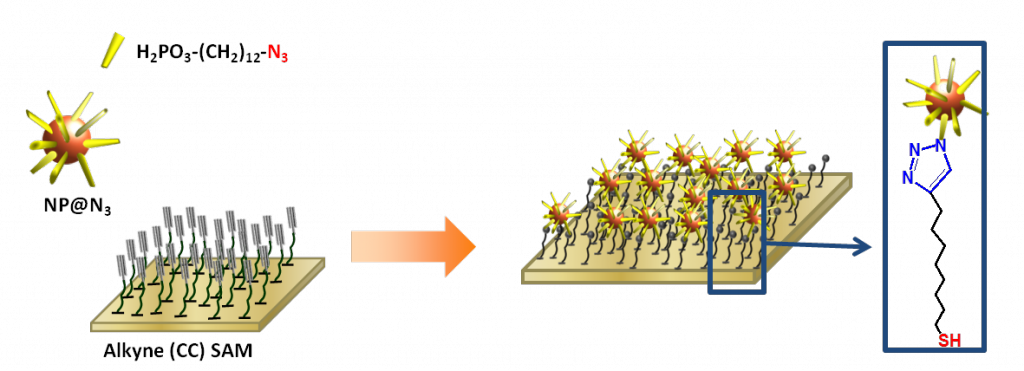
Assembling of functionalized nanoparticle by “click” chemistry
2D Assembling of Magnetic Iron Oxide Nanoparticles Promoted by SAMs Used as Well-Addressed Surfaces
B. P. Pichon, A. Demortière, M. Pauly, K. Mougin, A. Derory, S. Bégin-Colin, J. Phys. Chem. C, 2010, 114 (19), 9041–9048.
2D assemblies of non-interacting magnetic iron oxide nanoparticles via ‘‘click’’ chemistry
D. Toulemon, B. P. Pichon, X. Cattoen, M. Wong Chi Man, S. Begin-Colin, Chem. Commun., 2011, 47 (43), 11954 – 11956.
Fast
Assembling of Magnetic Iron Oxide Nanoparticles by Microwave-Assisted
Copper(I) Catalyzed Alkyne−Azide Cycloaddition (CuAAC)
Delphine
Toulemon, Benoît P. Pichon, Cédric Leuvrey, Spyridon Zafeiratos,
Vasiliki Papaefthimiou, Xavier Cattoën, Sylvie Bégin-Colin, Chem.
Mater., 2013, 25(14), 2849-2854.
Control of the structure of nanoparticle assemblies and modulation of collective properties
Our approach consists in the modulation of the structure of the assembly as function of the dimensionality and of the interparticle distance in order to control dipolar interactions which rule the collective properties. Low dimensionality favors the orientation of nanoparticle magnetic moments in a specific direction and results in strong dipolar interactions and collective properties while large interparticle distances render magnetic nanoparticle individual because dipolar interactions are weak.
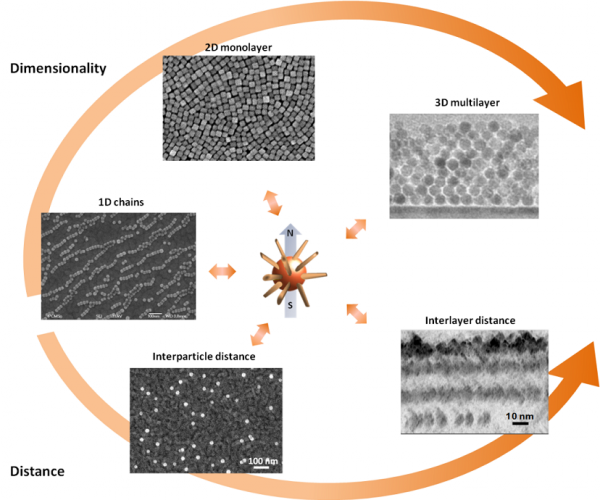
Control of the dimensionality and of the interparticle distance in nanoparticle assemblies
The effect of the dimensionality on dipolar interactions has been demonstrated by applying magnetic field in the parallel and in the perpendicular direction to the plan of the assembly. 2D monolayers favor stronger dipolar interactions than 3D multilayers prepared by the Langmuir-Blodget technique because the variation of the coercive field is the highest.

Size dependent dipolar interactions in iron oxide nanoparticle monolayer and multilayer Langmuir–Blodgett films
M. Pauly, B. P. Pichon, P. Panissod, S. Fleutot, P. Rodriguez, M. Drillon, S. Begin-Colin, Journal of Material Chemistry, 2012, 22 (13), 6343 – 6350.
The effect of the interparticle distance on dipolar interactions has been demonstrated by controlling the density of nanoparticles as function of the kinetic of a “click” chemistry reaction on SAMs and of the steric hindrance of organic molecules grafted at the nanoparticle surface in 2D monolayer prepared by the Langmuir-Blodgett technique.

2D assemblies of non-interacting magnetic iron oxide nanoparticles via ‘‘click’’ chemistry
D. Toulemon, B. P. Pichon, X. Cattoen, M. Wong Chi Man, S. Begin-Colin, Chem. Commun., 2011, 47 (43), 11954 – 11956.
Spacing-dependent dipolar interactions in dendronized magnetic iron oxide nanoparticle 2D arrays and powders
S. Fleutot, G. Nealon, M. Pauly, B. P. Pichon, C. Leuvrey, M. Drillon,
J.-L. Gallani, D. Guillon, B. Donnio, S. Begin-Colin, Nanoscale , 2013, 5(4), 1507-1516.
The interlayer distance in multilayer assemblies has been controlled by means of the Layer-by Layer technique in collaboration with the group of G. Decher in Strasbourg. The enlargement of the interlayer distance leads to weaker dipolar interactions while it favors the antiparallel coupling of magnetic layers.

Magnetotunable Hybrid Films of Stratified Iron Oxide Nanoparticles Assembled by the Layer by Layer Technique
B. P. Pichon, P. Louet, M. Drillon, O. Felix, S. Begin-Colin, G. Decher , Chemistry of Materials, 2011, 23(16), 3668-3675.
The size of nanoparticle 2D assemblies has been controlled by phase segregation of molecules in SAMs and showed that large assemblies favor the strongest dipolar interactions.

Tunable Magnetic Properties of Nanoparticles 2D Assemblies Addressed by Mixed SAMs
B. P. Pichon, M. Pauly, P. Marie, C. Leuvrey, S. Begin-Colin, Langmuir, 2011, 27, 6235–6243.
The integration of magnetic nanoparticle assemblies in magneto-resistive devices has been performed by means of the Langmuir-Blodgett technique and shows the significant decrease of the resistance when applying a magnetic field in the plan of the assembly.
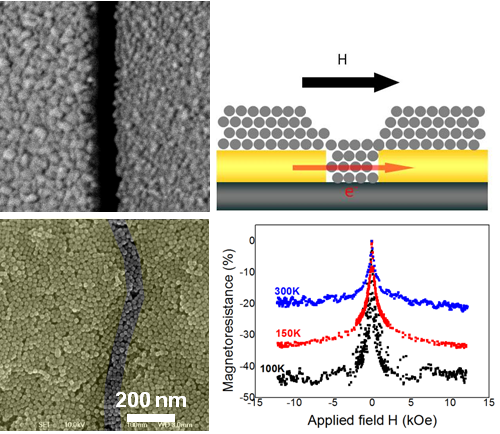
Co-tunneling Enhancement of the Electrical Response of Nanoparticle Networks
M. Pauly, J.-F. Dayen, D. Golubev, J.-B. Beaufrand, B. P. Pichon, B. Doudin, S. Bégin-Colin, Small, 2012, 8(1), 108-115.
Full bibliography on nanoparticle assembling
Magnetic Properties of Mono- and Multilayer Assemblies of Iron Oxide Nanoparticles Promoted by SAMs
Benoit P. Pichon, Cedric Leuvey, Dris Ihawakrim, Pierre Bernard, Guy Schmerber, Sylvie Begin-Colin, J. Phys. Chem. C, 2014, http://dx.doi.org/10.1021/jp412174k
Fast
Assembling of Magnetic Iron Oxide Nanoparticles by Microwave-Assisted
Copper(I) Catalyzed Alkyne−Azide Cycloaddition (CuAAC)
Delphine
Toulemon, Benoît P. Pichon, Cédric Leuvrey, Spyridon Zafeiratos,
Vasiliki Papaefthimiou, Xavier Cattoën, Sylvie Bégin-Colin, Chem.
Mater., 2013, 25(14), 2849-2854, http://dx.doi.org/10.1021/cm401326p.
Spacing-dependent dipolar interactions in dendronized magnetic iron oxide nanoparticle 2D arrays and powders
S. Fleutot, G. Nealon, M. Pauly, B. P. Pichon, C. Leuvrey, M. Drillon,
J.-L. Gallani, D. Guillon, B. Donnio, S. Begin-Colin, Nanoscale , 2013, 5(4), 1507-1516.
A Multiscale Structural Study of Nanoparticle Films Prepared by the Langmuir-Blodgett Technique
A. Dochter, B. P. Pichon, S. Fleutot, N. Médard, S. Bégin-Colin, Solid State Science, 2013, 16, 81-89.
Combined fitting of alternative and direct susceptibility curves of assembled nanostructures
Hillion, A. ; Pauly, M. ; Tamion, A. ; Tournus, F. ; Hillenkamp, M. ;
Pichon, B. P. ; Begin-Colin, S. ; Dupuis, V., Journal of Applied
Physics, 2012, 112, 123902/1.
Assembling of
Magnetic Iron Oxide Nanoparticles Controlled by Self-Assembled
Monolayers of Functional Coordinating or Chelating Trialkoxysilanes
B.P. Pichon, P. Buchwalter, C. Carcel, X. Cattoën, Michel, Wong Chi Man, S. Bégin-Colin, The Open Surface Science Journal, 2012, 4, 29-35.
Size dependent dipolar interactions in iron oxide nanoparticle monolayer and multilayer Langmuir–Blodgett films
M. Pauly, B. P. Pichon, P. Panissod, S. Fleutot, P. Rodriguez, M. Drillon, S. Begin-Colin, Journal of Material Chemistry, 2012, 22 (13), 6343 – 6350.
Co-tunneling Enhancement of the Electrical Response of Nanoparticle Networks
M. Pauly, J.-F. Dayen, D. Golubev, J.-B. Beaufrand, B. P. Pichon, B. Doudin, S. Bégin-Colin, Small, 2012, 8(1), 108-115.
2D assemblies of non-interacting magnetic iron oxide nanoparticles via ‘‘click’’ chemistry
D. Toulemon, B. P. Pichon, X. Cattoen, M. Wong Chi Man, S. Begin-Colin, Chem. Commun., 2011, 47 (43), 11954 – 11956.
Iron oxide magnetic nanoparticles used as probing agents to study the nanostructure of mixed self-assembled monolayers
B. P. Pichon, G. Barbillon, P. Marie, M. Pauly, S. Begin-Colin, Nanoscale, 2011, 3, 4696-4705 .
Monolayer and multilayer assemblies of spherically and cubic-shaped iron oxide nanoparticles
M. Pauly, B. P. Pichon, P.A. Albouy, S. Fleutot, C. Leuvrey,
M. Trassin, J.-L. Gallani, S. Begin-Colin, Journal of Material
Chemistry, 2011, 21 (40), 16018 – 16027.
Magnetotunable Hybrid Films of Stratified Iron Oxide Nanoparticles Assembled by the Layer by Layer Technique
B. P. Pichon, P. Louet, M. Drillon, O. Felix, S. Begin-Colin, G. Decher , Chemistry of Materials, 2011, 23(16), 3668-3675.
Tunable Magnetic Properties of Nanoparticles 2D Assemblies Addressed by Mixed SAMs
B. P. Pichon, M. Pauly, P. Marie, C. Leuvrey, S. Begin-Colin, Langmuir, 2011, 27, 6235–6243.
Nanotrench for nano and microparticle electrical interconnects
J.-F. Dayen, V. Faramarzi, M. Pauly, N. T. Kemp, M. Barbero, B. P.
Pichon, H. Majjad, S. Begin-Colin, B. Doudin, Nanotechnology, 2010, 21(33), 335303/1-335303/7.
Nematic-Like Organization of Magnetic Mesogen-Hybridized Nanoparticles
A. Demortière, B. P. Pichon, D. Guillon, S. Bégin-Colin, B. Donnio, Small, 2010, 12, 1341-1346.
2D Assembling of Magnetic Iron Oxide Nanoparticles Promoted by SAMs Used as Well-Addressed Surfaces
B. P. Pichon, A. Demortière, M. Pauly, K. Mougin, A. Derory, S. Bégin-Colin, J. Phys. Chem. C, 2010, 114 (19), 9041–9048.
Large 2D monolayer assemblies of iron oxide nanocrystals by the Langmuir-Blodgett technique
M. Pauly, B. P. Pichon, A. Demortière, J. Delahaye, C. Leuvrey, G. Pourroy, S. Bégin, Superlattices and Microstructures, 2009, 49, 195-204.
Formation of Ferrimagnetic Films with Functionalized Magnetite Nanoparticles Using the Langmuir-Blodgett Technique
F. Mammeri, Y. Le Bras, T. J. Daou, J.-L. Gallani, S. Colis, G.
Pourroy, B. Donnio, D. Guillon, S. Begin-Colin, Journal of Physical
Chemistry B, 2009, 113(3), 734-738.

